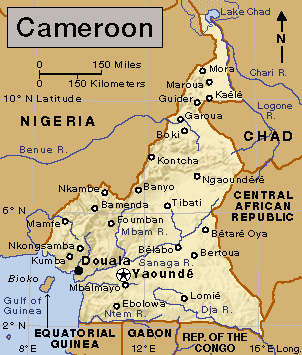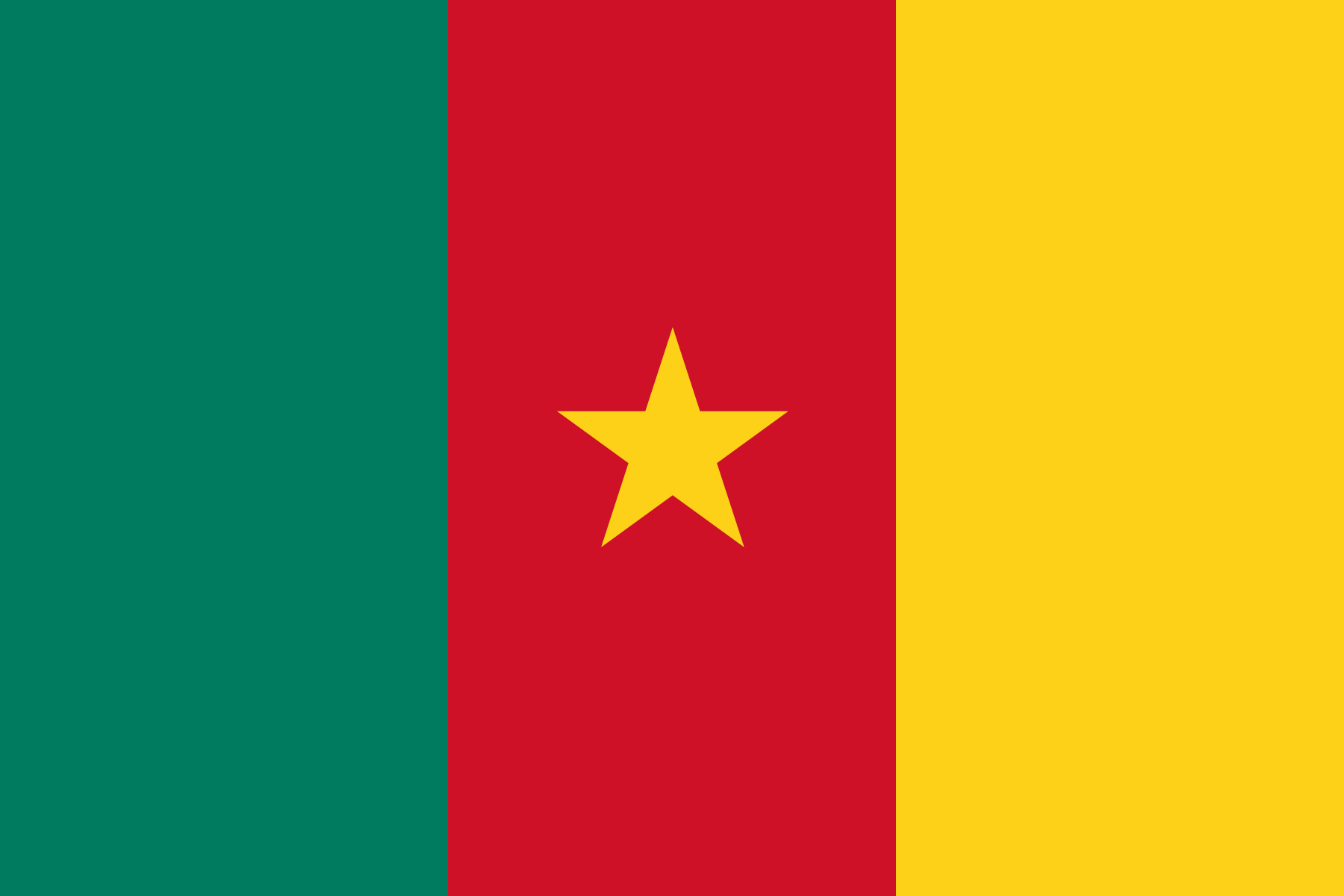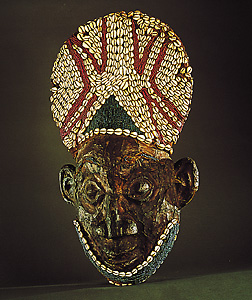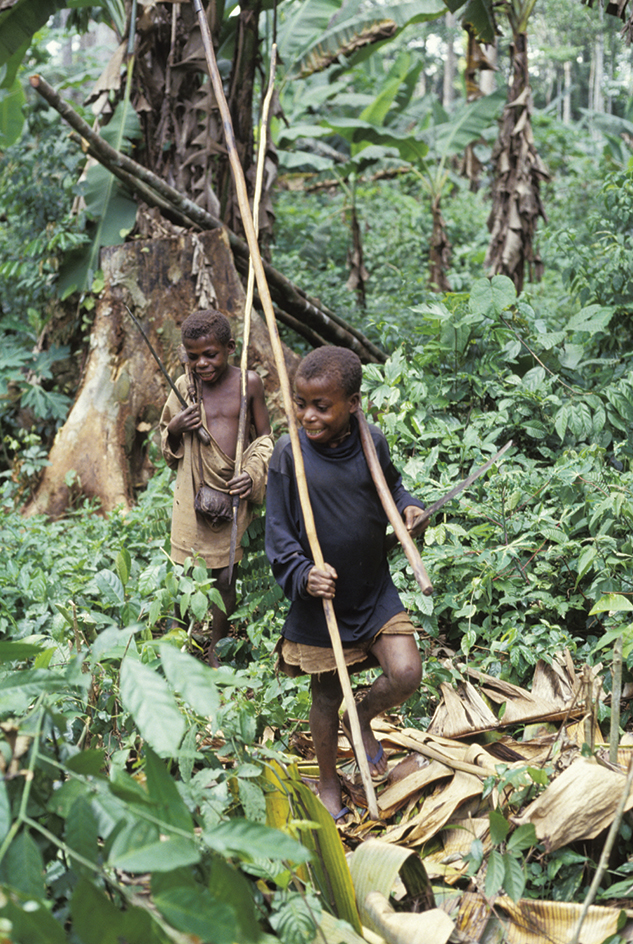Cameroon << `kam` uh ROON >> is a country on the west coast of Africa. It has a varied landscape, including mountains in the west, grasslands in the north, and tropical lowlands in the south. The people of Cameroon belong to about 200 ethnic groups. Yaoundé is the country’s capital, and Douala is its largest city.

Government.
A president, elected by the people to a seven-year term, is Cameroon’s head of state. This official holds the most power in the government. Cameroon has a bicameral (two-house) legislature, consisting of the National Assembly and the Senate. The people elect Assembly members. About two-thirds of the Senate is elected by regional councils. The president appoints the remaining members. Legislators in both houses serve five-year terms. The president appoints the prime minister, Cabinet members, and other officials to help carry out the functions of the government. Cameroon’s chief political party is the Cameroon People’s Democratic Movement. Cameroon is divided into 10 regions, each headed by a governor appointed by the president.

People.
Cameroon’s largest ethnic groups are the Bamileke, who live in the western region, and the Fulani, who live in the north. The Douala, the Ewondo, and the Fang inhabit the southern and central regions of Cameroon. English and French are Cameroon’s official languages, but most Cameroonians speak one of the country’s many African languages. About 40 percent of the people practice traditional African religions. About 40 percent are Christians. About 20 percent are Muslims.
Most of Cameroon’s rural people are farmers, but some are herders. The majority of the rural people live in villages or small towns. Manufacturing and service industries provide jobs in Cameroon’s urban areas. Each year, large numbers of rural people move to urban areas to seek jobs. Douala and Yaoundé, the chief cities in Cameroon, have elegant hotels, fine office buildings, and fashionable modern houses. But these cities also have areas in which many people live in slumlike conditions. The cities face the problem of accommodating the many rural people who move to the cities.
Most houses in the northern towns and villages are round clay huts or rectangular brick houses. Northern herders, who move from place to place, build light shelters from poles and woven mats. Most houses in the western mountainous region are square brick structures. Typical homes in the southern forest region are rectangular houses made of wood, palm leaves, and clay. Along the coast, people build wooden houses covered with tree bark or with sheets of metal. In the larger cities, many people live in modern houses and apartment buildings. But others in the cities live in shacks.
The government operates free public schools and universities, and gives financial aid to private schools. But Cameroon has shortages of schools and teachers, and many children do not attend school. About three-quarters of the nation’s adults can read and write.
Loading the player...Cameroonian folk chant
Artists in Cameroon are known for their woodcarving and brass masks. Some of the finest Cameroonian art is produced by the Bamileke and Bamoun peoples, who live in the Western Highlands.

Land and climate.
Mountains and hills lie along Cameroon’s western border, from Lake Chad in the north to Mount Cameroon in the south near the coast. Mount Cameroon, at 13,353 feet (4,070 meters), is the country’s highest point. A forested plateau in central Cameroon separates a savanna (grassland with scattered trees) in the north from tropical lowlands along the coast of the Gulf of Guinea in the south. Waza National Park in the north preserves an area of savanna inhabited by many animals, including elephants, giraffes, gazelles, and many species of birds. Cameroon has three main rivers, the Benue, the Wouri, and the Sanaga.

Cameroon’s northern savanna region is hot and dry most of the year. The average temperature is about 82 °F (28 °C), but daytime temperatures sometimes reach 120 °F (49 °C). The central plateau is cooler, with an average temperature of about 75 °F (24 °C). The coastal region is hot and humid. Some places there receive up to 200 inches (500 centimeters) of rain a year, and the average temperature is about 80 °F (27 °C).
Economy.
Despite having many natural resources, Cameroon is a poor country. Many of the country’s people live in poverty.
The economy of Cameroon depends largely on agriculture. About two-fifths of the country’s labor force works in agriculture. Leading crops include bananas, beans, cacao beans, cassava, corn, cotton, peanuts, sorghum, and taro. Farmers also raise beef and dairy cattle and chickens.
In the 1970’s, Cameroon began pumping petroleum from the Gulf of Guinea. Today, petroleum is Cameroon’s most important mined product. Bauxite, which is used to make aluminum, is also important. Trees in the country provide palm oil, rubber, and timber. Cameroon has few large manufacturing and processing industries. The industries include the manufacture of aluminum products, beverages, cement, food products, and petroleum products.
Aluminum, cocoa, cotton, petroleum, and wood products are Cameroon’s main exports. Imports include food, machinery, and transportation equipment. Cameroon’s chief trading partners include China, France, Italy, the Netherlands, Nigeria, and the United States.
Most of Cameroon’s roads are unpaved. Railroads link the larger cities and towns of the country. Douala, Garoua, and Yaoundé have international airports. 
Cameroon’s leading daily newspaper, the Cameroon Tribune, publishes in both English and French. The country has both state-owned and privately owned radio and television stations.
History.
Stone tools and rock carvings found in Cameroon indicate that prehistoric people lived in the area. Bantu-speaking people were one of the earliest identified groups to settle in Cameroon. They lived in the northern highlands hundreds of years before Christ. A state called Kanem that existed from about the A.D. 700’s extended into present-day Cameroon.
In the late 1400’s, Portuguese explorers became the first Europeans to reach Cameroon. The country’s name comes from camarões, the Portuguese word for shrimp. The Portuguese had found small crayfish that looked like shrimp in the Wouri River. From the late 1400’s to the late 1800’s, other Europeans flocked to the area. Many of them went to Cameroon to participate in the flourishing slave trade there. The United Kingdom abolished its slave trade in 1807, and many other European nations did so in the early 1800’s. Ivory and palm oil became the major trade products after the slave trade ended. In 1858, British missionaries established Victoria, the first permanent European settlement in Cameroon, at the base of Mount Cameroon.
In the late 1800’s, three European countries—the United Kingdom, France, and Germany—struggled for control of Cameroon. In 1884, two local Douala chiefs signed a treaty with Germany that made Cameroon a German protectorate—that is, a territory under partial German control. Germany lost control of Cameroon to the United Kingdom and France during World War I (1914-1918). In 1922, the United Kingdom and France divided Cameroon into two sections. The British section included two separated parts along the western border. Called British Cameroons, the sections made up about one-fifth of Cameroon. The other four-fifths came under the control of France and was called French Cameroun. Each section was governed according to the laws of the ruling country and adopted the ruling country’s language as the official one. In 1946, the United Kingdom and France pledged to eventually give their parts of Cameroon self-government or independence.
On Jan. 1, 1960, French Cameroun became the independent Republic of Cameroon. Ahmadou Ahidjo became president of the new country. In an election in February 1961, the people in the two parts of British Cameroons were given the choice of joining their territory with the new Republic of Cameroon or with neighboring Nigeria. Voters in the northern part chose to join Nigeria, and their area became part of that country on June 1, 1961. Voters in the southern part chose to join the Republic of Cameroon. This union took place on Oct. 1, 1961. From then until early 1972, Cameroon operated as a federation of two states—East Cameroon and West Cameroon. Then in May 1972, Cameroon adopted a new constitution that united the two separate states.
Ahidjo resigned as president in 1982. His prime minister, Paul Biya, became president. Until 1991, Biya’s political party—the Cameroon People’s Democratic Movement (CPDM)—was the only one allowed in Cameroon. In 1991, other political parties were legalized. In 1992, Cameroon held its first multiparty elections. Biya was elected president, and the CPDM won a majority in the National Assembly. Biya was reelected president in 1997, 2004, 2011, and 2018. The CPDM remained in power after legislative elections in 1997, 2002, and 2013.
Early in 2015, Boko Haram, an Islamist terrorist group based in neighboring Nigeria, attacked villages in Cameroon. Cameroon then joined a military coalition with Benin, Chad, Niger, and Nigeria against Boko Haram.
